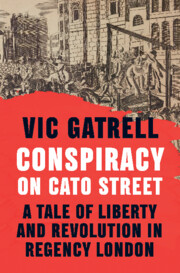Book contents
- Conspiracy on Cato Street
- Conspiracy on Cato Street
- Copyright page
- Epigraph
- Contents
- Illustrations and Maps
- Preface
- Acknowledgements
- Abbreviations
- Timeline
- A Note on the Text
- Part One The Simple Tale
- Part Two Taking Its Measure
- Part Three Thistlewood: His Story
- Part Four Ordinary Britons
- Chapter 13 Conspirators and Others
- Chapter 14 Wives, Marriages, Children
- Chapter 15 Men of Colour: Wedderburn and Davidson
- Part Five The Executions
- The People Listed
- Historiographical Note
- Trial Reports
- Notes
- Bibliography
- Index
Chapter 14 - Wives, Marriages, Children
from Part Four - Ordinary Britons
Published online by Cambridge University Press: 06 April 2022
- Conspiracy on Cato Street
- Conspiracy on Cato Street
- Copyright page
- Epigraph
- Contents
- Illustrations and Maps
- Preface
- Acknowledgements
- Abbreviations
- Timeline
- A Note on the Text
- Part One The Simple Tale
- Part Two Taking Its Measure
- Part Three Thistlewood: His Story
- Part Four Ordinary Britons
- Chapter 13 Conspirators and Others
- Chapter 14 Wives, Marriages, Children
- Chapter 15 Men of Colour: Wedderburn and Davidson
- Part Five The Executions
- The People Listed
- Historiographical Note
- Trial Reports
- Notes
- Bibliography
- Index
Summary
The five widows of the executed conspirators and the five wives whose men were transported leave poignant records of both impoverishment and courage. Before the trials, most couples seem to have been faithful to each other, William Davidson excepted.Left with 26 children to care for between them, the women had no support other than radicals’ charity. Most disappeared miserably from history.But Susan Thistlewood and Arthur’s illegitimate son Julian made good in the long run: Julian became a Parisian painter and fathered a noted impressionist. And Ings the butcher’s letters to his wife Celia suggest a loving marriage, and she lived adequately as a widow.
- Type
- Chapter
- Information
- Conspiracy on Cato StreetA Tale of Liberty and Revolution in Regency London, pp. 305 - 320Publisher: Cambridge University PressPrint publication year: 2022

